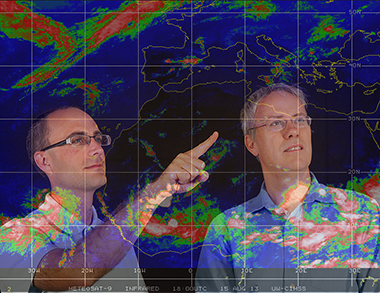UAlbany Atmospheric Scientists Study African Easterly Waves
Results Could Help West Africa with Weather and Agriculture Prediction, Health Assessments
 |
|
Atmospheric scientists Ryan Torn, left, and Chris Thorncroft. (Photo by Mark Schmidt) |
ALBANY, N.Y. (October 2, 2013) — UAlbany atmospheric scientists Chris Thorncroft and Ryan Torn are working to improve knowledge and understanding of African Easterly Waves (AEWs) and their relevance to a range of applications vitally important for West African nations, including hydrology and flood prediction, agriculture and crop prediction, and malaria risk assessments.
The study, which is being supported by a National Science Foundation grant, will be shared with scientists working in these geographic areas within the African Monsoon Multidisciplinary Analysis project, in which Thorncroft has a leadership role.
“AEWs are one of the major weather makers over West Africa,” explained Thorncroft. “These weather systems not only provide rainfall for agriculture, but trigger hurricanes that cross the Atlantic to our shores. Despite their importance little is known about their variability and degree of predictability.”
Thorncroft, chair of the Department of Atmospheric and Environmental Sciences, is concentrating on understanding how the structures of AEWs change under different conditions and the extent to which AEW characteristics vary at daily-to-intraseasonal timescales. An expert in large-scale topical meteorology, his research focus has enhanced understanding of the West African monsoon and how it interacts with the tropical Atlantic to form hurricanes.
Torn, an expert in hurricanes, atmospheric predictability and computer weather models, is working on improving our understanding of the predictability of AEWs under a variety of conditions by using forecast sensitivity analyses. His efforts will interact strongly with and benefit from the variability work of Thorncroft, and determine to what extent existing models can be used for accurate prediction.
“Increased knowledge and understanding of the variability and predictability of AEWs is important for weather forecasters concerned with the West African region as well as those interested in the potential for tropical cyclogenesis [cyclone development] downstream,” said Thorncroft. “In particular, we will endeavor to include more information about sub-seasonal variations of AEWs and associated rainfall.”
Torn noted that “AEWs develop where waves of relatively moist cold air from the Atlantic ocean meets with much warmer and drier air from the Sahara, providing us an opportunity to understand atmospheric predictability for a class of phenomenon where dry and moist dynamics are of equal importance, unlike midlatitude systems that are primarily associated with dry dynamics.”
The project will also employ two graduate students, who will begin their work on the project at UAlbany in spring 2014.
![]() For more news, subscribe to UAlbany's RSS headline feeds
For more news, subscribe to UAlbany's RSS headline feeds
A comprehensive public research university, the University at Albany-SUNY offers more than 120 undergraduate majors and minors and 125 master's, doctoral and graduate certificate programs. UAlbany is a leader among all New York State colleges and universities in such diverse fields as atmospheric and environmental sciences, business, education, public health,health sciences, criminal justice, emergency preparedness, engineering and applied sciences, informatics, public administration, social welfare and sociology, taught by an extensive roster of faculty experts. It also offers expanded academic and research opportunities for students through an affiliation with Albany Law School. With a curriculum enhanced by 600 study-abroad opportunities, UAlbany launches great careers.


